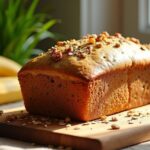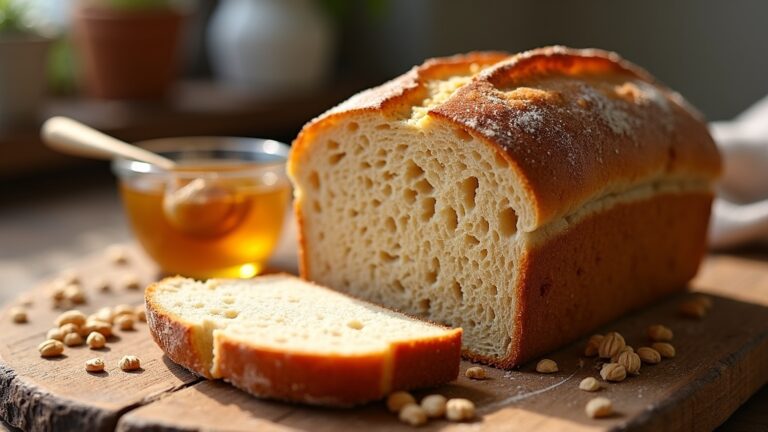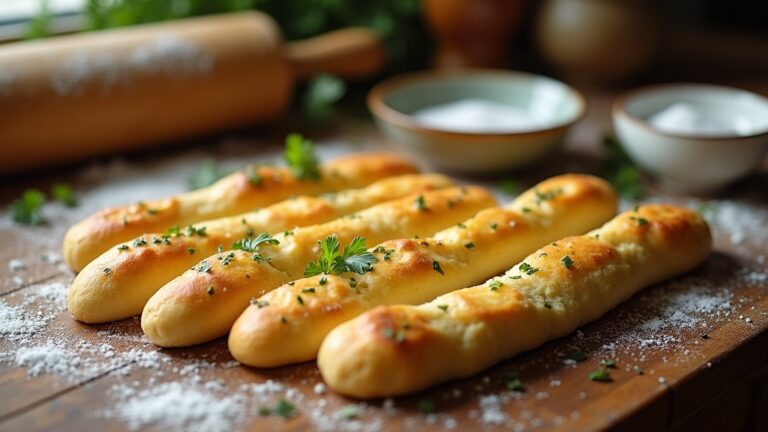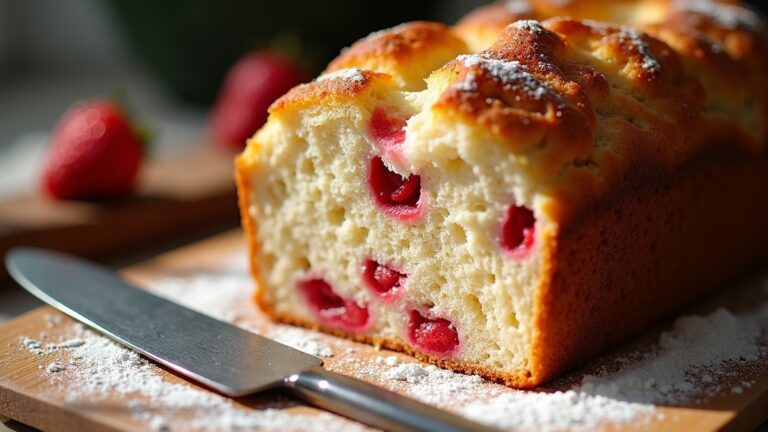Bread Pudding Recipe Old Fashion
I’ve perfected my old-fashioned bread pudding recipe, turning stale bread into a warm, comforting dessert that’s rich in flavor and history. With simple ingredients like milk, eggs, and sugar, it creates a delightful custardy center and a crispy top. I love serving it warm, drizzled with caramel or paired with ice cream for an indulgent treat. If you’re curious about the steps and customizing tips for this nostalgic classic, stick around for more details!
Contents
History
Bread pudding has a rich history that dates back to ancient times, when people sought ways to avoid wasting food. Its medieval origins saw creative cooks transform stale bread into a delightful dessert. Imagine the resourcefulness of those early chefs, blending simple ingredients like milk, sugar, and eggs to create something extraordinary. As time passed, the culinary evolution of bread pudding took shape, adapting to regional flavors and ingredient availability. From the spiced versions of Europe to the fruity variations found in the Caribbean, each culture added its unique twist. This dish not only showcases innovation but also reflects our enduring desire to make the most out of what we have. It’s fascinating how a simple recipe can tell such a rich story, don’t you think?
Recipe
Bread pudding is a delightful dessert that transforms stale bread into a warm, comforting dish that is perfect for any occasion. With its origins in frugal cooking, this classic recipe has evolved over time, incorporating various flavors and ingredients to suit different tastes. The beauty of bread pudding lies in its versatility; you can use any type of bread, from brioche to sourdough, and add a variety of ingredients like chocolate, fruits, and spices to make it uniquely yours.
To create a mouthwatering bread pudding, the key is to allow the bread to soak in the custard mixture long enough to absorb the flavors while still maintaining some texture. The result is a rich, custardy center with a slightly crispy top that is simply irresistible. Serve it warm with a drizzle of caramel sauce or a scoop of vanilla ice cream for a truly indulgent treat.
Ingredients:
- 6 cups of cubed stale bread
- 4 cups of milk
- 4 large eggs
- 1 cup of granulated sugar
- 1 teaspoon of vanilla extract
- 1 teaspoon of ground cinnamon
- ½ teaspoon of salt
- ½ cup of raisins or chocolate chips (optional)
- 2 tablespoons of butter (for greasing the baking dish)
Cooking Instructions:
Preheat your oven to 350°F (175°C) and grease a 9×13 inch baking dish with butter. In a large bowl, combine the milk, eggs, sugar, vanilla extract, cinnamon, and salt, whisking until well blended. Add the cubed bread and optional raisins or chocolate chips to the mixture, ensuring all the bread pieces are fully coated. Let it sit for about 15-20 minutes to allow the bread to soak up the custard mixture. Pour the mixture into the prepared baking dish and bake for 45-50 minutes or until the top is golden brown and the custard is set.
Extra Tips:
For added flavor, consider experimenting with different types of bread, such as croissants or challah, which can bring a richer taste to your bread pudding. You can also enhance the dish with spices like nutmeg or cardamom, or add a splash of bourbon or rum for a more adult version. If you want to make it ahead of time, you can assemble the bread pudding the night before, refrigerate it, and then bake it the next day. Enjoy your delicious creation!
Cooking Steps
Now that we’ve gathered our ingredients, it’s time to bring this bread pudding to life! First, I’ll preheat the oven to 350°F, ensuring it’s just right for our sweet creation. Then, I’ll combine the bread and milk, setting the foundation for a deliciously rich texture.
Step 1. Preheat the Oven to 350°F
Before diving into the delicious process of making bread pudding, let’s get our oven ready by preheating it to 350°F. This oven temperature is essential because it guarantees the pudding bakes evenly, allowing those delightful flavors to meld perfectly. As I set my oven, I like to give it a few minutes to reach that sweet spot; trust me, it makes a difference. One of my favorite baking tips is to keep an eye on the oven while it preheats, making certain it doesn’t get too hot too quickly. A well-preheated oven is the foundation of a successful bread pudding, so let’s embrace this simple step and get excited about the journey ahead!
Step 2. Combine Bread and Milk
With the oven preheating to that perfect temperature, it’s time to combine the bread and milk. I love using a mix of bread varieties—thick slices of brioche, crusty French bread, or even day-old challah bring unique textures and flavors. Now, let’s consider our milk types. Whole milk lends a rich creaminess, while almond or oat milk offers a delightful twist for a dairy-free option. I pour the milk over the torn bread pieces, ensuring every morsel soaks up that luscious liquid. As I gently press down, I can feel the bread absorbing the warmth and flavors, creating a harmonious blend. This step sets the stage for a decadent bread pudding that’s both comforting and innovative.
Step 3. Add Eggs and Sugar
As I whisk together the eggs and sugar, the mixture transforms into a velvety blend that promises to add richness to our pudding. I prefer using large organic eggs, as they deliver a deeper flavor. For those seeking innovation, experimenting with different egg types, like duck or quail eggs, can elevate the dish further. Next, I introduce sugar alternatives such as maple syrup or coconut sugar, which lend a unique twist while keeping the dish wholesome. As the sweetness melds with the eggs, I can already envision the delightful texture of the final product. This step is essential; it not only binds our ingredients but also infuses the pudding with a luscious, custard-like quality that’s simply irresistible.
Step 4. Fold in Raisins and Spices
Once the eggs and sugar have come together in a luscious blend, it’s time to infuse our pudding with flavor by folding in the raisins and spices. I love using a medley of raisin varieties to create depth; golden raisins add a touch of sweetness, while dark raisins bring a rich, tart contrast. As I mix them in, I also sprinkle in my favorite spice blends—think cinnamon, nutmeg, and a whisper of allspice. The aroma alone is intoxicating! Gently incorporating these ingredients guarantees they’re evenly distributed throughout the mixture, allowing every bite to burst with flavor. This step transforms our simple pudding into a delightful dessert, celebrating both tradition and innovation. Let’s make this pudding unforgettable!
Step 5. Pour Mixture Into Baking Dish
Now, let’s gently pour our luscious mixture into a prepared baking dish, ensuring every drop makes it in. As I do this, I’m reminded of crucial baking techniques that elevate this classic dessert. I tilt the bowl, allowing the rich custard to flow smoothly, coating the bread and raisins perfectly. It’s essential to distribute the mixture evenly, so I use a spatula to scrape out every last bit. Once filled, I give the dish a gentle shake to settle everything nicely. For serving suggestions, I love pairing this warm bread pudding with a drizzle of caramel sauce or a scoop of vanilla ice cream. Trust me, your guests will be delighted by this innovative twist on an old favorite!
Nutritional Guide
Bread pudding isn’t just a comforting dessert; it’s also a surprisingly nutritious choice when made with wholesome ingredients. I love how this dish can be tailored to fit various dietary considerations, making it flexible and enjoyable for everyone. When I prepare it, I focus on balancing the caloric content while enhancing flavors with fruits and nuts. Here’s a quick look at the nutritional aspects of a typical serving:
| Nutrient | Amount per Serving |
|---|---|
| Calories | 250 |
| Protein | 6g |
| Fiber | 3g |
Final Thoughts
While many desserts can be indulgent, I believe bread pudding strikes a perfect balance between comfort and nutrition. This classic comfort food is not just a simple dish; it’s a canvas for creativity. You can easily transform it into exciting dessert variations by experimenting with flavors, like adding chocolate, seasonal fruits, or spices. Each tweak opens up new possibilities, making it a delightful treat for any occasion. I love how bread pudding can evoke nostalgia while still allowing for innovation. Whether you enjoy it warm with a drizzle of caramel or chilled with a scoop of ice cream, it’s truly a versatile dessert. So, why not embrace this timeless recipe and create your own delightful version? You won’t regret it!
Frequently Asked Questions
Can I Use Stale Bread for Bread Pudding?
I love using stale bread for bread pudding. It soaks up the custard beautifully, enhancing the bread texture. Trust me, the result is a deliciously rich dessert that transforms leftover bread into something extraordinary!
What Types of Bread Work Best for This Recipe?
When it comes to bread pudding, I love using brioche bread for its richness and sourdough bread for its tang. Both add unique flavors, creating a delightful twist on this classic dessert that’s simply irresistible!
How Long Can I Store Leftover Bread Pudding?
I’ve found that storing leftover bread pudding in the fridge lasts about three to four days. For longer storage, I freeze it, ensuring I’ve got delicious leftover recipes ready whenever I crave that comforting treat.
Can I Freeze Bread Pudding for Later Use?
I love freezing bread pudding for later! Using proper freezing techniques helps maintain its delicious texture. Just wrap it tightly, and you’ll enjoy its comforting flavors even after it’s been tucked away in the freezer.
What Are Some Popular Toppings for Bread Pudding?
Imagine warm, gooey bread pudding topped with a rich caramel sauce, glistening like liquid gold. A dollop of fluffy whipped cream crowns it all, creating a delightful contrast that elevates every bite into pure bliss.
Conclusion
As I savor each warm, custardy bite of this old-fashioned bread pudding, I can’t help but wonder: what memories does this comforting dessert evoke for you? This classic recipe not only warms the belly but also nourishes the soul, connecting us to generations past. With its simple ingredients and timeless flavors, it’s a delightful reminder of home and tradition. So, why not gather your loved ones and share this delicious experience? Trust me, it’s worth it!










